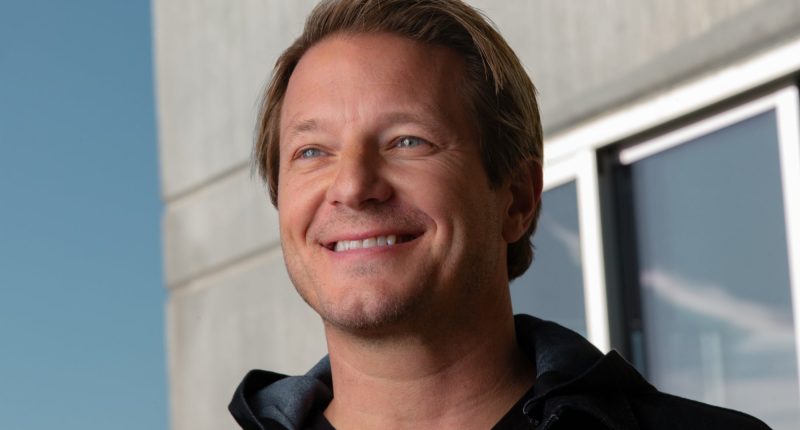This Side Hustle Spotlight Q&A features Shawn Nelson, founder and CEO of furniture manufacturer Lovesac. The company saw annual revenue over $650 million in the fiscal year ending January 29, 2023.
 Image Credit: Courtesy of Lovesac
Image Credit: Courtesy of Lovesac
When did you start Lovesac as a side hustle, and what inspired it?
It’s 1995, and I’m 18, sitting on my parents’ couch in Salt Lake City, Utah. One morning, I had an idea and thought, Wouldn’t it be funny to make a giant beanbag chair — like the size of my entire living room floor? So, I got off the couch, drove down to the fabric store and bought enough fabric for something that massive. Then, I began sewing it together. It took three weeks to fill it up with soft stuff I cut up from around the house — but everywhere I took it, people loved it and begged me to make them one. Eventually, I did. It cost me $25 to register the name, and in October 1998, Lovesac officially began as a company.
What were some of the first steps you took to get that side hustle off the ground?
When I started college at the University of Utah, I lived in my parents’ basement, which was the perfect place to roll out huge, long rolls of fabric. My buddies and I would make the Sacs in the basement and sell them at our college. We quickly became known as the “Lovesac guys” around campus, with even the frats and sororities buying a few Sacs for their houses. From there, we were a fixture at any event we could find — boat shows, home shows, car shows, Oktoberfest — and this is how we grew the company in those earliest days.
Were there challenges that came with running the side hustle? If so, how did you navigate those?
After two or three years of running Lovesac as a side hustle in college, it was apparent that it would not make any real money in its current form. In fact, it probably cost me money to keep it alive. Sure, we’d make a profit selling the product — but then the van would break. Or the foam shredder would break. Or the state would fine me and my buddies for some workplace violation. The bottom line is: Building a business is hard, and it can take a lot of money to make it to some kind of meaningful critical mass.
As we grew, I was working harder than ever. It was draining, but I couldn’t help but give it one last shot at a trade show in Chicago, hoping to get to the next level. One of the biggest retailers in the U.S. placed an order for 12,000 Sacs, not knowing that it was just me and a buddy working out of a rundown building with a wood chipper as a foam shredder.
Despite every inefficiency, we completed the order, but then we realized we had no other big customers to sell to. We went to the furniture stores, but they all laughed at us and said it was a stupid idea — so we decided to open our own store. The first Lovesac store opened on November 17, 2001.
 Image Credit: Courtesy of Lovesac
Image Credit: Courtesy of Lovesac
When did you decide to take the business from side hustle to full-time venture?
Our first store changed everything — this is when I pivoted the company to a full-time venture. Consumers were obsessed with Lovesac. They came in, bought Sacs, flopped down and hung out with friends. The product was the best sales pitch we could give. We were doing six figures in just the first few weeks, and I had never seen money like that. We promptly ran off to open the second store in Provo, Utah, then Las Vegas, Phoenix, and Southern California. Growth went ballistic.
What were some of the biggest hurdles that came up over the years once you were running the business full-time? How did you overcome those?
We had grown to 35-40 locations when I got recruited to be on Richard Branson‘s reality TV show, The Rebel Billionaire, in 2005. It was a national primetime show on Fox Network, and I won a $1 million investment! Of course, I was $2 million in debt, having built this growing retail chain, but what are you going to do? We took the winnings, paid off some debt and raised more money through venture capital. However, the venture capitalists wanted to bankrupt the company and start over cleanly through Chapter 11 reorganization. I was devastated. We had made it all this way, yet somehow, the only way forward was to begin again.
We moved the company to Stamford, Connecticut, downsized the staff to a skeleton crew and started over with just 12 locations and about 12 employees at our tiny new HQ on the East Coast. It was the right move in the long run. We learned, focused and built the company back up to 30, 40, then 50 locations. Some people might have coasted after that, but I got another wild idea. Ironically, this one happened because of a couch, too.
In that first store, we had a couch in the corner to show the Sacs in a living room-type environment. We noticed that customers always asked to buy the couch, but it was too big to sell. So, the idea was, What if we could shrink down this couch the way we shrink down our Sacs? And that’s how the concept of Sactionals was born.
In 2012, Lovesac was named the fastest-growing furniture company in the U.S. by Furniture Today — what made that rapid growth possible? How has the company approached scaling over the years?
Around this time, I recognized that if we were going to really compete, we needed to pivot the business. With this in mind, I changed our focus to becoming a direct-to-consumer furniture brand with Sactionals as the primary driver. I took a risk and invested in local and then national TV advertising for the Sactionals, along with every emerging digital approach. Sactionals quickly became the fastest-selling couch solution in the United States. Lovesac expanded to nearly 80 locations, and then [we] took the company public in 2018 with $100 million in sales.
After you go public, the sky’s the limit. The company was worth $200-300 million overnight. It felt like a dream; I couldn’t believe it. We grew to hundreds of locations by the 2020s. We have thousands of employees, and we’ve been named the fastest-growing furniture company in the U.S. numerous times. Our sales have multiplied and will likely grow to a billion dollars and beyond. The Sactionals gave us a new future. Their rapid adoption revealed that people love the idea of things being built to last a lifetime and designed to evolve with you throughout your life. We’re proving that planned obsolescence was the wrong way to make a brand that lasts. We call this new approach to innovation Designed for Life, and it will inform everything we do from here on out.
 Image Credit: Courtesy of Lovesac
Image Credit: Courtesy of Lovesac
What is the company’s current valuation? How much revenue does it bring in today?
Looking back at the past year, Lovesac’s growth and performance results are a testament to the resilience of our brand and disruptive business model that has consistently delivered category outperformance and customer loyalty. Through a challenging year for our category, we’ve been able to maintain momentum with our commitment to product innovation, compelling marketing and a highly productive omnichannel footprint. These strategies continue to drive consumer demand and further distinguish our unique brand from a crowded market. Looking ahead, we believe that we are poised to continue investing in the future with an accelerated pace of expansion and innovation to further garner customer enthusiasm.
Prior to reporting year-end results, Wall Street analysts estimate Lovesac’s sales for the fiscal year that just ended to come in at around $700 million, with high single-digit adjusted EBITDA profitability. The company has fluctuated in multiples and market cap valuations over the past four years hovering in the $300-400 million range, peaking at over $1 billion in 2021 when the home category hit all-time highs during the pandemic.
When you look to your company’s future, what are you most excited about?
At Lovesac, innovation is at the center of our design philosophy as we continue to prioritize developing breakthrough technologies and pushing the boundaries of what’s possible in the furniture category. Challenging traditional definitions of comfort and home style is what has set the Lovesac brand apart since its inception, and over the past few years, we’ve been working with a variety of high-end fashion brands in the space to create something truly unique in the market. Anti Social Social Club, Jeremy Scott, alice + olivia and KidSuper are among the brands that have collaborated on covers and accoutrements for our two signature styles. We look forward to creating a blend of fashion-forward design and unparalleled comfort that speaks to the modern consumer.
What are some of the biggest lessons you’ve learned over the course of your entrepreneurial journey?
In my new memoir Let Me Save You 25 Years: Mistakes, Miracles, and Lessons from the Lovesac Story, I detail the ups and downs of my 25-year saga building the Lovesac business from its days as a college side hustle to a successful IPO on the NASDAQ stock exchange and beyond. If you can learn from my mistakes, however, then perhaps your ambitions, big or small, can be realized in less than the 25-plus years it has taken me to finally learn something and get somewhere with mine.
Here are some of the biggest lessons I’ve learned:
1. Heed what the experts have to say, but on occasion, you need to trust your gut.
2. There comes a point before any major change in your career, business or personal life where you can greatly improve your odds for good outcomes by making a bold decision to ditch the safety net and fully commit.
3. Play along the way, taking the time you need to keep yourself relaxed and sharp.
4. You’re no good to anyone as a miserable, uptight workaholic.
Do you have any advice for others interested in starting a side hustle or business of their own?
The entrepreneurial journey I’ve faced over the past quarter-century has been full of triumphant victories and humbling defeats, born from sweat, tears and relentless determination. With my new podcast series and memoir, I look forward to creating and fostering a sense of community through these channels and shining a light on real, raw stories from industry trailblazers on the movements they have built to bring valuable insights and knowledge to those that seek it.
Growing Lovesac into what it is has taken my entire adult life and is the hardest thing I’ve ever done. I have so many memories and have built so many lifelong friends throughout this journey that make all the stumbles, roadblocks, sleepless nights and unrelenting stress worth it. My advice for anyone considering starting down the road of being a founder would be this: Get off the couch! Trust your instincts, and just keep going. That life-changing moment could be right around the corner, and the last thing you want to do is turn back just before you arrive.
Entrepreneurship is a never-ending pursuit, but the journey is the gift. With an open mind, an honest heart, some ambition, time, help and a little bit of luck, all things are possible.








